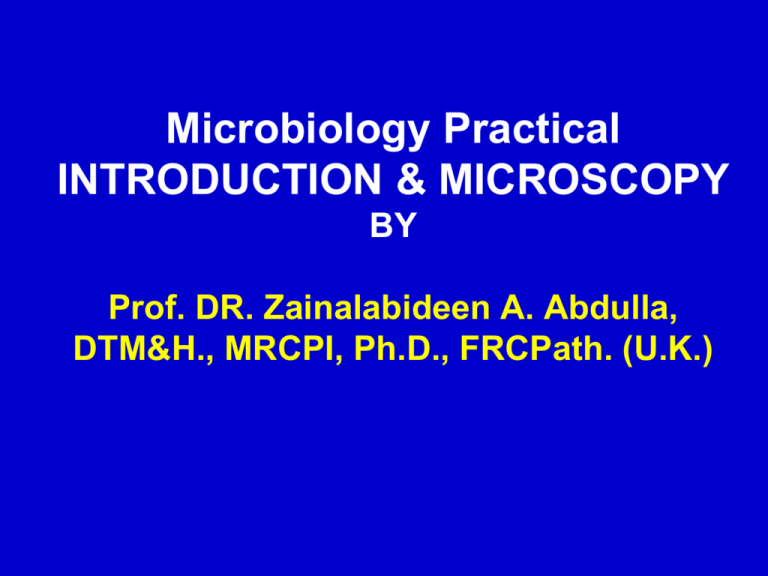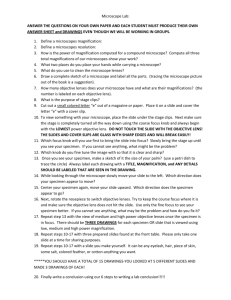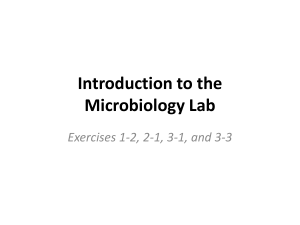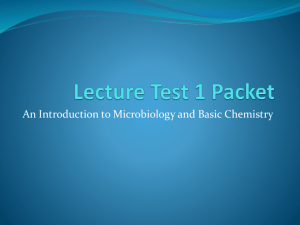Lab 1
advertisement

Microbiology Practical INTRODUCTION & MICROSCOPY BY Prof. DR. Zainalabideen A. Abdulla, DTM&H., MRCPI, Ph.D., FRCPath. (U.K.) Learning Objectives of Microscopy Lab. To be familiarized with: 1. Theoretical principles of bright-field microscope 2. Component parts of compound microscopes 3. Use and care of a microscope 4. Practical uses of compound microscope using the different objective lenses for stained specimens. Microbes * Very tiny (small) * Require microscope to see them * Size & volume: Metric - Micrometer “µm” (10-6 meter) = Micron (µ) - Nanometer “nm” (10-9 meter) = Millimicron (mµ) * Microbes : - Coccus (spherical) = 1 µm - Bacillus (rod) = 3 µm long - Viruses = 0.01-0.3 µm - Fungi = 2 - 30 µm - Parasites = 5- 2000 µm Types of Microscopes - For magnification - Ordinary: Unable to distinguish= < 0.1 mm 1. Compound microscope (Brightfield): - Visualizes surface morphology - NOT internal structures - Lenses: 1. Ocular lens (Eyepiece) 2. Objective lens (Nosepiece) 3. Condenser (sub-stage) 3. No contrast: For nonviable (not living) objects 2. Dark Field microscope - Specimen: Bright - Background: Dark - Stop-Block for the surrounding (light is deflected, but illuminate the specimen) 3. Phase-Contrast - For unstained, living cells - Phase-contrast objective & Condenser - Refractive index: Difference between specimen & surrounding - Background: Bright, Specimen: Dark 4. Fluorescent microscope - Fluorescent dye -Ab specimen (Ag) - UV light: - High Pressure Mercury Lamp - Hydrogen Quartz Lamp - Ocular lens with filter - Wave length = 230 – 350 nm - Colours of dyes: Green, Yellow, Orange 5. Electron microscope - Beam of electrons, NOT light - Focusing: Electromagnetic in vacuum - A. Transmission EM 1. Thin, fixed, and dehydrated specimen 2. Visualize internal cellular structures - B. Scanning EM 1. Three-Dimensional 2. Surface characteristic - Example of EM use: Viruses Electron Microscopes (EM): 1. Transmission (TEM) - X 1 Million - Killed microbes 2. Scanning (SEM) -100X less magnification than TEM - Surface examination of microbes Atomic Force Microscopes: - Living organisms Components of Microscope 1. Stage 2. Illumination (light source) 3. Condenser (2 sets lenses + diaphragm) 4. Body tube (adjustable): - Upper: Eye piece (Ocular piece) - Lower: Nose piece (Objective lenses) Adjustment: - Coarse adjustment knob - Fine adjustment knob Resolution (resolving) power - TWO adjacent objects = 0.2 µm Refractive Index - Air < glass (light lost by reflection) - Compensate by oil (RI oil = RI glass) When oil- immersion lens is used Use and care of the microscope - Follow your handout instructions - Clean: Xylene/Absolute Alcohol+ Lens Paper - Image: Up-side- Down Practical Use 1. Materials 2. Procedure - Use the 4 objective lenses - Look at gram positive, gram negative 3. Use of oil immersion 4. Self-assessment exercise/ use your text book (Burton’s Microbiology Safety Measures in Microbiology Laboratory 1. No food or drinks are permitted in the laboratory at any time. 2. Only closed-toe shoes are to be worn in the laboratory. Sandals are not permitted. 3. Keep hands and other objects away from your face, nose, eyes, ears, and mouth. The application of cosmetics in the laboratory is prohibited in the laboratory 4. Work areas/surfaces must be disinfected before and after use. 5. Laboratory coats must be worn and buttoned while in the laboratory. Laboratory coats should not be worn outside the laboratory. 6. Protective eyewear must be worn when performing any exercise or procedure in the laboratory. 7. Long hair should be secured behind your head. 8. Hands must be washed before leaving the laboratory. 9. All unnecessary books, purses, briefcases, etc., must be kept off the countertops. 10. Never pipette anything by mouth (including water). Always use pipetting devices. Cont./… Safety Measures in Microbiology 11. Label all materials with your name, date, and any other applicable information (e.g., media, organism, etc.). 12. Dispose of wastes in their proper containers 13. When handling chemicals, note the hazard code on the bottle and take the appropriate precautions indicated. 14. Do not pour chemicals down the sink. 15. Return all chemicals, reagents, cultures, and glassware to their appropriate places. 16. Do not pour bio-hazardous fluids down the sink. 17. Glassware should be washed with soap and water, then rinsed with distilled water. 18. Flame transfer loops, wires, or needles before and immediately after use to transfer biological material. 19. Do not walk about the laboratory with transfer loops, wires, needles, or pipettes containing infectious material. 20. Be careful around Bunsen burners. Flames cannot always been seen. Cont./… Safety Measures in Microbiology 21. Turn off incinerators (burners) before leaving the laboratory. 22. Report any broken equipment. 23. Immediately, report any broken glass, especially those containing infectious materials. 24. If you are injured in the laboratory, immediately contact your course instructor. 25. Any chemical or biological fluid spills must be immediately reported to your course instructor. 26. Follow all instructors given by your course instructor for cleaning up any spills or broken glass. 27. Familiarize yourself with safety equipment in the laboratory and emergency escape routes. 28. Always wipe and clean the lenses of your microscope before putting it away. Use the appropriate tissue paper and cleaning solution for this purpose. 29. Use appropriate universal precautions with all biological fluids. 30. Do not remove any materials from the laboratory without taking the permission of your course instructor.






